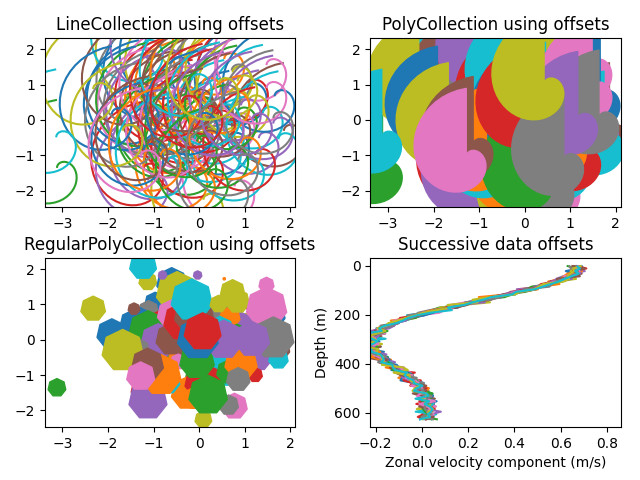Nota
Haga clic aquí para descargar el código de ejemplo completo
Colección Line, Poly y RegularPoly con ajuste de escala automático #
Para las dos primeras subtramas, usaremos espirales. Su tamaño se establecerá en unidades de parcela, no en unidades de datos. Sus posiciones se establecerán en unidades de datos utilizando los argumentos de palabra clave offsets y offset_transformLineCollection de
y PolyCollection.
La tercera subparcela hará polígonos regulares, con el mismo tipo de escalado y posicionamiento que en las dos primeras.
La última subparcela ilustra el uso de "offsets=(xo, yo)", es decir, una sola tupla en lugar de una lista de tuplas, para generar curvas de compensación sucesivas, con la compensación dada en unidades de datos. Este comportamiento solo está disponible para LineCollection.
import matplotlib.pyplot as plt
from matplotlib import collections, colors, transforms
import numpy as np
nverts = 50
npts = 100
# Make some spirals
r = np.arange(nverts)
theta = np.linspace(0, 2*np.pi, nverts)
xx = r * np.sin(theta)
yy = r * np.cos(theta)
spiral = np.column_stack([xx, yy])
# Fixing random state for reproducibility
rs = np.random.RandomState(19680801)
# Make some offsets
xyo = rs.randn(npts, 2)
# Make a list of colors cycling through the default series.
colors = [colors.to_rgba(c)
for c in plt.rcParams['axes.prop_cycle'].by_key()['color']]
fig, ((ax1, ax2), (ax3, ax4)) = plt.subplots(2, 2)
fig.subplots_adjust(top=0.92, left=0.07, right=0.97,
hspace=0.3, wspace=0.3)
col = collections.LineCollection(
[spiral], offsets=xyo, offset_transform=ax1.transData)
trans = fig.dpi_scale_trans + transforms.Affine2D().scale(1.0/72.0)
col.set_transform(trans) # the points to pixels transform
# Note: the first argument to the collection initializer
# must be a list of sequences of (x, y) tuples; we have only
# one sequence, but we still have to put it in a list.
ax1.add_collection(col, autolim=True)
# autolim=True enables autoscaling. For collections with
# offsets like this, it is neither efficient nor accurate,
# but it is good enough to generate a plot that you can use
# as a starting point. If you know beforehand the range of
# x and y that you want to show, it is better to set them
# explicitly, leave out the *autolim* keyword argument (or set it to False),
# and omit the 'ax1.autoscale_view()' call below.
# Make a transform for the line segments such that their size is
# given in points:
col.set_color(colors)
ax1.autoscale_view() # See comment above, after ax1.add_collection.
ax1.set_title('LineCollection using offsets')
# The same data as above, but fill the curves.
col = collections.PolyCollection(
[spiral], offsets=xyo, offset_transform=ax2.transData)
trans = transforms.Affine2D().scale(fig.dpi/72.0)
col.set_transform(trans) # the points to pixels transform
ax2.add_collection(col, autolim=True)
col.set_color(colors)
ax2.autoscale_view()
ax2.set_title('PolyCollection using offsets')
# 7-sided regular polygons
col = collections.RegularPolyCollection(
7, sizes=np.abs(xx) * 10.0, offsets=xyo, offset_transform=ax3.transData)
trans = transforms.Affine2D().scale(fig.dpi / 72.0)
col.set_transform(trans) # the points to pixels transform
ax3.add_collection(col, autolim=True)
col.set_color(colors)
ax3.autoscale_view()
ax3.set_title('RegularPolyCollection using offsets')
# Simulate a series of ocean current profiles, successively
# offset by 0.1 m/s so that they form what is sometimes called
# a "waterfall" plot or a "stagger" plot.
nverts = 60
ncurves = 20
offs = (0.1, 0.0)
yy = np.linspace(0, 2*np.pi, nverts)
ym = np.max(yy)
xx = (0.2 + (ym - yy) / ym) ** 2 * np.cos(yy - 0.4) * 0.5
segs = []
for i in range(ncurves):
xxx = xx + 0.02*rs.randn(nverts)
curve = np.column_stack([xxx, yy * 100])
segs.append(curve)
col = collections.LineCollection(segs, offsets=offs)
ax4.add_collection(col, autolim=True)
col.set_color(colors)
ax4.autoscale_view()
ax4.set_title('Successive data offsets')
ax4.set_xlabel('Zonal velocity component (m/s)')
ax4.set_ylabel('Depth (m)')
# Reverse the y-axis so depth increases downward
ax4.set_ylim(ax4.get_ylim()[::-1])
plt.show()

Referencias
En este ejemplo se muestra el uso de las siguientes funciones, métodos, clases y módulos: